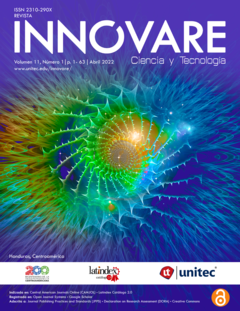Crime incidents and police interventions in Honduras from 2013 to 2020
DOI:
https://doi.org/10.5377/innovare.v11i1.14073Keywords:
Geospatial analysis, Principal component, Correlation, Crime incidentsAbstract
Introduction. Honduras has a high level of violence in Latin America. This study analyzed crime and policing incidents at the municipal level in Honduras from 2013 to 2020. Methods. Data from the Online Police Statistical System of the 298 municipalities over a period of 8 years were used, and geospatial, correlation, principal component (PCA) and factorial (AF) analyzes were performed. Results. The Central District and San Pedro Sula are the municipalities with the highest number of incidents. The trend in the period was a decrease in reports of abortions, homicides, stabbing or firearm injuries, undetermined deaths, police deaths, abductions, kidnappings, rapes and attempts. The incidences that increased were traffic accidents and their injuries or deaths, injuries with a blunt weapon, peaceful or violent demonstrations, accidental deaths, deaths by suspension, injured police officers, and suicides. There were significant levels of correlation between the different incidences, e.g., accidental deaths, due to traffic accidents, undetermined deaths and abortions, as well as the ability of the applied PCA to reduce dimensions from 20 incidences to only 2, 3 or 4 components. Conclusion. The correlations showed groups of police incidents concentrated in the urban areas of the country. A multidimensional behavior of the variables was observed, whose attention would contribute to population peace and security through preventive and corrective measures.
Downloads
1275
PDF (Español (España)) 395
Published
How to Cite
Issue
Section
License
Copyright (c) 2022 Henry Osorto

This work is licensed under a Creative Commons Attribution-NonCommercial-NoDerivatives 4.0 International License.




